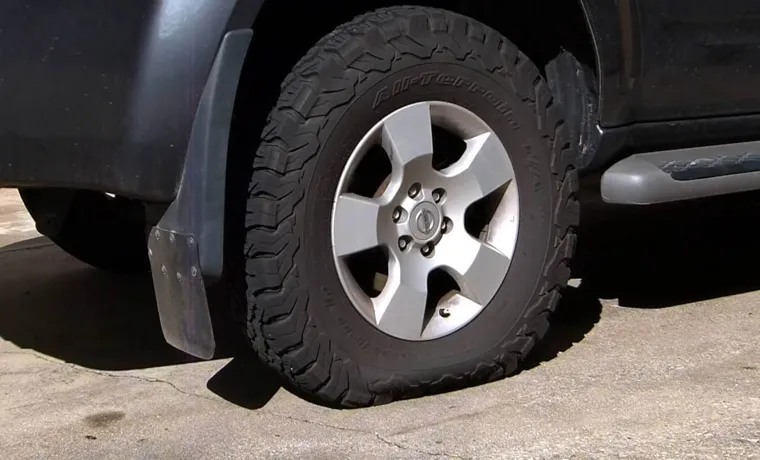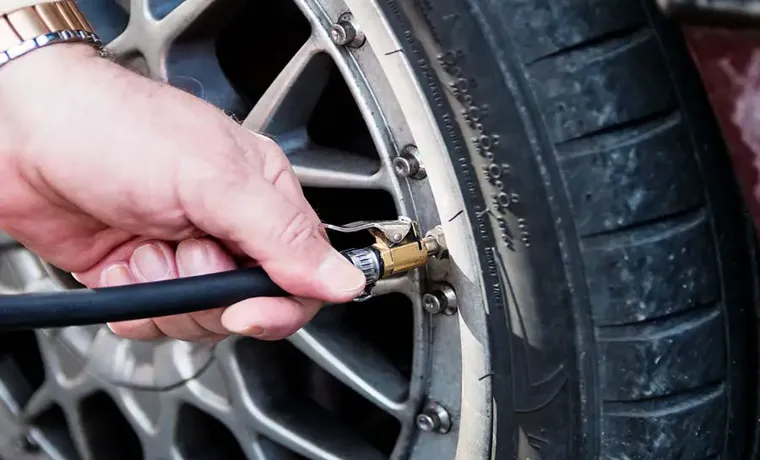Have you ever noticed your car feeling a little wobbly or uneven while driving? Maybe you’ve even felt a slight pull to one side. These could be signs that one or more of your tires is deflating, which is not only inconvenient but also unsafe. If you’re wondering how long it takes for a tire to deflate and what causes it, keep reading to find out.
A deflated tire can be caused by a variety of factors, from punctures to temperature changes, and the time it takes for it to become noticeable depends on the severity of the issue. Understanding the signs of a deflating tire and how to prevent it can save you time, money, and maybe even a potential accident. So, let’s dive in and learn more about tire deflation.
Table of Contents
Factors That Affect Tire Deflation Time
Have you ever wondered how long it takes for a tire to deflate? Well, there are several factors that come into play. The size of the tire is one factor, as larger tires tend to hold more air and take longer to deflate. The temperature outside can also affect the deflation time, with colder temperatures causing air to contract and escape more slowly, while warmer temperatures can cause the air to expand and escape more quickly.
The type of tire also matters, with run-flat or reinforced tires taking longer to deflate due to their special construction. Additionally, the severity of the puncture or damage to the tire can affect how quickly it loses air. Although there is no set time frame for tire deflation, it is important to regularly check your tire pressure to ensure safe driving conditions.
Remember, proper maintenance is crucial for safety on the road.
Size and Type of the Tire
Tire deflation time can vary depending on the size and type of the tire. Larger tires typically take longer to deflate than smaller ones, as they have more air volume to release. The type of tire also plays a role in how quickly it deflates.
Run-flat tires, for example, are designed to maintain some level of shape and structure even with low air pressure, meaning they will take longer to deflate than regular tires. Other factors that can affect tire deflation time include the temperature and the rate of puncture. In general, the slower the puncture, the longer it will take for the tire to fully deflate.
This can be an advantage as it gives drivers more time to safely pull over and get help. On the other hand, sudden or rapid deflation can be dangerous, especially if it occurs at high speeds or on a busy road. Ultimately, it’s crucial to regularly check your tire pressure and to be aware of any signs of damage or wear, as this can help prevent unexpected deflation incidents and keep you safe on the road.

Temperature and Pressure
When it comes to tire deflation time, two factors that play a significant role are temperature and pressure. Although these factors may seem minor, they can have a significant impact on the longevity of your tires and, subsequently, the safety of your vehicle. Temperature affects the air pressure within your tire, as it causes the air molecules to expand, resulting in an increase in tire pressure.
Conversely, cold temperatures cause the air molecules to compress, lowering the tire’s air pressure. This can cause your tire to lose air over time, resulting in deflation. High tire pressure can also cause tires to wear out faster and make steering difficult, while low tire pressure can lead to increased rolling resistance, poor handling, and increased fuel consumption.
Therefore, it’s essential to keep a close eye on your tire pressure and make adjustments as needed to ensure your tires are in optimal condition.
Puncture Size and Location
When it comes to tire deflation time, there are various factors to consider. One of the most significant factors is the size and location of the puncture. The size of the puncture affects the pressure loss rate.
The larger the puncture, the faster the tire will lose air. Additionally, the location of the puncture plays a huge role in how quickly a tire deflates. If the puncture is located on the sidewall, road damage or foreign objects are more likely to quickly cause a flat tire.
Whereas, punctures on the tread area tend to take longer to deflate because of the sturdy structure. Understanding the size and location of the puncture can significantly impact the ability to prevent tire deflation or take speedy action in response. Keeping a close eye on your tires and looking for any potential road damage can save time, money and a headache.
Typical Deflation Rates
If you’re wondering how long it takes for a tire to deflate, that depends on various factors such as the size and type of the tire, the temperature, and the driving conditions. However, typical deflation rates for a car tire range from 1-3 psi per month and can go up to 10 psi per day in the case of extreme punctures or severe damages. It’s important to maintain proper tire pressure to ensure your safety and prolong the lifespan of your tires.
You can check your tire pressure regularly using a tire gauge and follow the recommended pressure levels provided by your vehicle’s manufacturer or the tire manufacturer. Neglecting tire care can lead to increased fuel consumption, decreased handling and stability, and potential accidents. Therefore, it’s crucial to take tire maintenance seriously and address any issues as soon as they arise.
Slow Leaks
Slow leaks in tires are common occurrences, and they can cause a significant drop in air pressure over time. The typical deflation rate of a tire can range between 1 to 3 PSI per month, depending on various factors such as temperature, altitude, and tire usage. These factors can speed up or slow down the rate of tire deflation.
Therefore, it is essential to check your tire pressure regularly, preferably once a month, to ensure that it does not fall below the recommended level. Proper tire maintenance is crucial to ensure optimal vehicle performance and safety. Suppose you notice that the tire pressure drops more quickly than it usually does, and you cannot seem to locate a nail or puncture in the tire.
In that case, it may be a slow leak caused by a valve problem or a rim that does not maintain its seal. Don’t wait until it is too late – make sure to address these issues promptly to avoid accidents and prolong your tire’s lifespan.
Fast Leaks
When it comes to leaks, speed is vital. Fast leaks can quickly lead to disastrous consequences, which is why recognizing typical deflation rates is essential. The rate at which a tire deflates depends on various factors, such as the size and type of the puncture.
A small puncture may take a few minutes to release all the air, while a larger one can deflate the tire in seconds. Generally, tires lose about 1-2% of their air pressure per month, but this can vary depending on weather conditions, temperature, and altitude. It’s crucial to monitor your tire pressure regularly to catch any fast leaks early and avoid serious accidents.
Remember that deflated tires can affect your vehicle’s handling, fuel efficiency, and overall safety on the road. Don’t let fast leaks ruin your ride; be proactive and stay safe by maintaining your tires in optimal condition.
What to Do When Your Tire Starts Deflating
When you notice your tire starting to deflate, it’s important to act quickly to avoid a potential blowout or accident. But how long does it take for a tire to deflate? The answer depends on several factors, such as the size of the puncture or leak, the type of tire, and the weight of your vehicle. In general, a slow leak in a tire can take anywhere from several hours to a few days to completely deflate.
However, if you notice a sudden loss of air pressure, the tire may have a larger puncture or tear that can cause it to deflate much more quickly. In any case, it’s best to pull over and inspect your tire as soon as you notice it deflating, and be sure to have a spare tire and necessary tools on hand in case you need to change it. Don’t risk driving on a deflated tire, as it can cause serious damage to your vehicle and put you and other drivers in danger on the road.
Find a Safe Place to Pull Over
If you’re driving and you feel your tire starting to deflate, it’s important to find a safe place to pull over as quickly as possible. The first step is to stay calm and avoid slamming on the brakes, which could cause your vehicle to swerve or lose control. Instead, gradually slow down while maintaining control of your steering.
Look for a nearby parking lot, rest area, or other safe location to pull over. If you’re driving on a busy highway or road, try to make your way to the right shoulder or emergency lane. Once you’ve pulled over, turn on your hazard lights to alert other drivers that you’re stopped.
Remember to stay inside your vehicle and avoid changing the tire until you’re in a safe and secure location. If you’re unsure of what to do, don’t hesitate to call for roadside assistance. By taking these steps, you can stay safe and avoid the danger of a blown-out tire or other tire-related accidents.
Assess the Damage and Severity of the Deflation
When you’re driving and your tire starts deflating, panic can set in. But don’t worry, there are some easy steps you can take to handle the situation. First, assess the damage and severity of the deflation.
If it’s a slow leak, you may be able to make it to a mechanic. However, if it’s a blowout, pull over to a safe location immediately. Next, check your tire pressure using a gauge.
If the pressure is low, remove the tire and locate the puncture. If the damage is severe, it may be time to replace the tire. Keep in mind that deflated tires can affect your handling and braking, so drive with caution.
Overall, don’t let a deflating tire ruin your day. Stay calm, assess the situation, and take the necessary steps to get back on the road safely. Remember, always prioritize safety over convenience.
Call for Assistance or Change the Tire Yourself
When a tire starts deflating, it can be a frustrating situation that requires immediate attention. The first thing you should do is assess the severity of the problem. If the tire is completely flat, you will need to change it yourself or call for assistance.
If the tire is slowly losing air, you may be able to make it to a nearby gas station or tire store. If you’re comfortable changing a tire, grab your spare tire, jack, and lug wrench. Loosen the lug nuts before jacking up the car, then remove the flat tire and replace it with the spare.
Once the spare tire is on, tighten the lug nuts in a star pattern and lower the car back down. Remember to get the flat tire repaired or replaced as soon as possible. If changing a tire isn’t for you, don’t worry.
Many roadside assistance services offer tire-changing as part of their packages. Some car insurance policies even offer roadside assistance as a benefit. Calling for assistance can save you time and energy, and ensure the tire is changed safely.
In conclusion, assessing the severity of a deflating tire is crucial in determining whether to call for assistance or change it yourself. If you’re comfortable with changing the tire, make sure to follow the proper steps and get the flat tire repaired or replaced quickly. If not, roadside assistance can be a valuable resource to help you get back on the road safely.
Remember to always stay aware of your surroundings and drive carefully to prevent future tire issues.
Conclusion
In summary, the question ‘how long does it take for a tire to deflate?’ may seem simple at first glance, but in reality, there are a number of variables at play. From the size and type of tire, to the temperature and driving conditions, the speed of the deflation process can vary greatly. But one thing is for certain – just like a punctured balloon, a deflated tire can bring your plans crashing down.
So, always keep an eye on your tire pressure and don’t let a flat ruin your ride!”
FAQs
How can I tell if my tire is deflating?
Keep an eye on the tire pressure monitoring system in your car. If you notice a drop in pressure, it may be a sign of a deflating tire.
How long does it take for a tire to fully deflate?
It depends on the severity of the puncture, but it can take anywhere from a few seconds to several minutes for a tire to fully deflate.
Can a deflated tire be repaired?
Yes, a deflated tire can often be repaired by patching the puncture hole or replacing the valve stem. However, if the tire is severely damaged, it may need to be replaced entirely.
What causes a tire to deflate?
A tire can deflate due to a puncture, a leaky valve stem, or damage to the wheel rim.
Can driving on a deflated tire cause damage to my car?
Yes, driving on a deflated tire can cause damage to your car’s suspension system, as well as to the tire itself.
How often should I check my tire pressure to prevent deflation?
It’s a good idea to check your tire pressure at least once a month, and more frequently during extreme temperature changes.
Is it safe to drive on a partially deflated tire?
No, driving on a partially deflated tire can cause it to wear unevenly and potentially blow out, leading to a dangerous situation on the road. Always inflate your tires to the recommended pressure.



